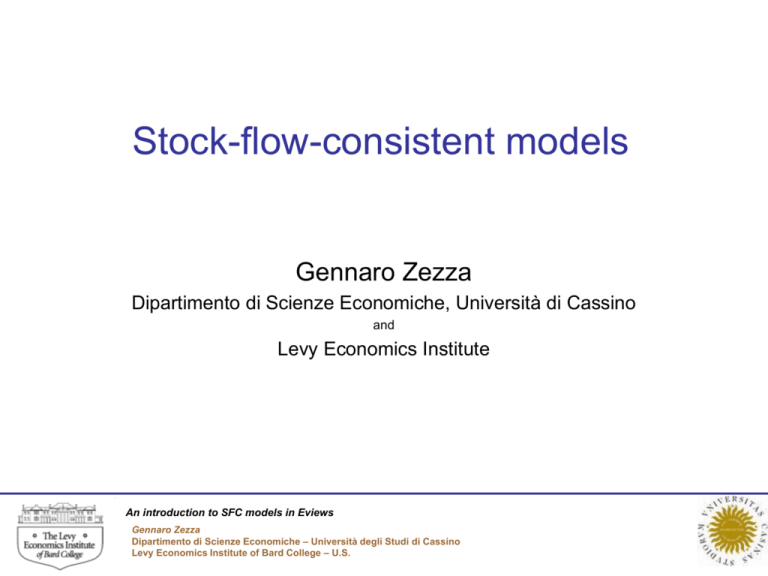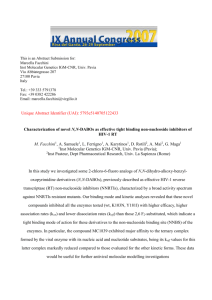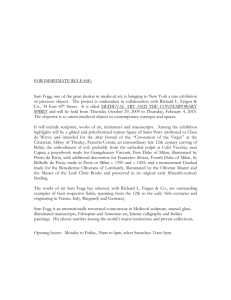GZxPavia1
advertisement

Stock-flow-consistent models
Gennaro Zezza
Dipartimento di Scienze Economiche, Università di Cassino
and
Levy Economics Institute
An introduction to SFC models in Eviews
Gennaro Zezza
Dipartimento di Scienze Economiche – Università degli Studi di Cassino
Levy Economics Institute of Bard College – U.S.
G. Zezza – Stock-flow-consistent
models #1 - Pavia, June 2011 - 1/14
Course outline
• A general introduction to theoretical stockflow-consistent models
• Designing the model
– Stocks matrix
– Flows matrix
• The simplest model: a stationary, closed
economy
• A growing economy
• A
growing
economy
with
portfolio
management
• An open economy model?
G. Zezza – Stock-flow-consistent models #1 - Pavia, June 2011 - 2/14
Reasons to be interested in SFC models
• Most (all?) mainstream models failed to
predict the crisis
• Most people who saw the crisis coming had
some underlying model linking supply and
demand in real markets, and supply and
demand for financial assets (credit)
• International and national organizations
(Oecd, EC, ECB…) have recently started
projects for collecting more systematically
flow of funds data
• There is a strong demand, among institutions
which rely on forecasts, for models which
integrate real and financial markets
G. Zezza – Stock-flow-consistent models #1 - Pavia, June 2011 - 3/14
Other reasons to be interested…
• The SFC approach provides a method
for investigating the economy as a
whole
• It may provide a unifying framework to
discuss heterodox approaches
• No need for micro-foundations?
• SFC and agent-based modeling
• A lot of work needs to be done…
G. Zezza – Stock-flow-consistent models #1 - Pavia, June 2011 - 4/14
Background - Godley
Wynne Godley
• Interested in tracking the “real economy” (not
so much in academic debates)
• Started his work (at the Treasury) when data
and computers were not readily available
• Production takes time. Therefore requires
finance
• “New Cambridge”: stability of stock-flow
ratios. Levy model: analysis of financial
balances
G. Zezza – Stock-flow-consistent models #1 - Pavia, June 2011 - 5/14
The “New Cambridge” hypothesis
Y=C+I+G+X–M
Y – T + Tr - C = I + (G – T) + (X – M + Tr)
S = I + DEF + BP
NAFA = S – I = DEF + BP
• If NAFA is stable relative to income, any
increase in government deficit will be
mirrored in the external balance (twin
deficits)
G. Zezza – Stock-flow-consistent models #1 - Pavia, June 2011 - 6/14
Wealth to income ratio
Dt = a1*Yt + a2*FAt-1
DFAt = Yt - a1*Yt - a2*FAt-1
FAt – (1-a2)*FAt-1 = (1 - a1)*Yt
FA*[1-(1-a2)/(1+g)] = (1 - a1)*Y
• For stable parameters in the private
demand equation, and a stable growth
rate, the stock-flow ratio FA/Y has to be
stable
G. Zezza – Stock-flow-consistent models #1 - Pavia, June 2011 - 7/14
Financial balances
G. Zezza – Stock-flow-consistent models #1 - Pavia, June 2011 - 8/14
How to read financial balances
• As they are drawn in the previous charts,
financial balances represent addition to
aggregate demand (injections)
• A given growth rate in output can be achieved
with any combination of financial balances
• However, when a balance to output ratio
exceeds the growth rate of output (roughly)
the underlying stock/output ratio is growing
G. Zezza – Stock-flow-consistent models #1 - Pavia, June 2011 - 9/14
Debt and deficit
Debt = Debt(-1) + GD { + capital gains}
D/Y = D(-1)/[Y(-1)*(1+g)] + GD/Y
d = d(-1)/(1+g) + gd
Dd = d(-1)*[-g/(1+g)] + gd
Assume d = 100%; g = 5%: if gd > 4,8% the debt/output
ratio will be growing. For d = 50%, the debt/output ratio
will grow when gd > 2.4% etc.
Financial balances relative to GDP can be roughly
compared to the GDP growth rate, to see if the
underlying stock of assets/debt is growing
G. Zezza – Stock-flow-consistent models #1 - Pavia, June 2011 - 10/14
Movements in the balances
• When one of the financial balances
increases, the contribution of that sector to
aggregate demand is growing
• The other balances will be adjusting
• We need a (SFC!) model to examine the links
among balances
• Godley used to say that these models are a
“tool for thinking”. He did not trust fancy
econometrics techniques
G. Zezza – Stock-flow-consistent models #1 - Pavia, June 2011 - 11/14
Links between real and financial markets
• Saving for each sector determines the
increase in net wealth, along with credit
• Credit conditions matter for investment
decisions
• Financial stocks imply interest payments and
capital gains/losses which are relevant for
investment and consumption decisions
• Wealth is relevant for consumption and
investment decisions
G. Zezza – Stock-flow-consistent models #1 - Pavia, June 2011 - 12/14
Portfolio management: Tobin
• The allocation of wealth among financial
assets is determined by (expected) relative
rates of return, and liquidity preference
• The set of equations is such to ensure that
any increase in one asset is matched by a
decrease in other assets (if we want to hold
more equities we want to hold less bonds)
and that reactions to changes in rates of
return are symmetric.
G. Zezza – Stock-flow-consistent models #1 - Pavia, June 2011 - 13/14
Summing up
• SFC models a la Godley start from standard
Keynesian features
– Demand led models
– Quantity adjustment
– Price setting is related to income distribution
• But they include links between stocks and flows
– Convergence towards income/wealth ratio for
households
– Convergence towards a desired capital/output ratio
– Debate on rate of capacity utilization
– Convergence for stock of government debt?
– Foreign debt?
G. Zezza – Stock-flow-consistent models #1 - Pavia, June 2011 - 14/14




